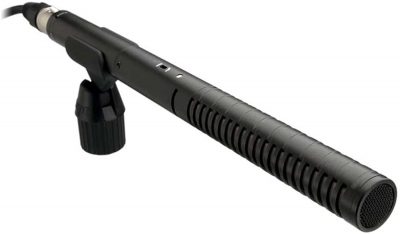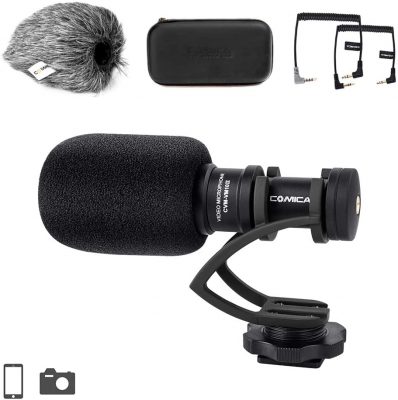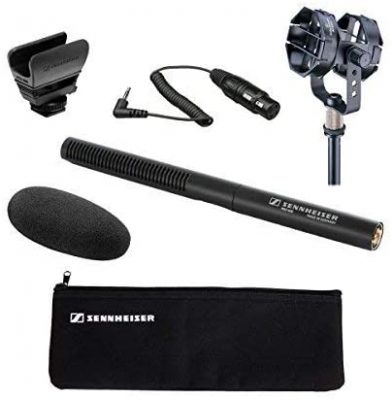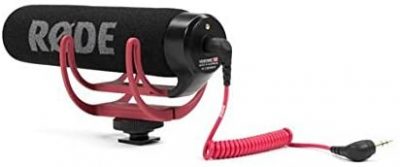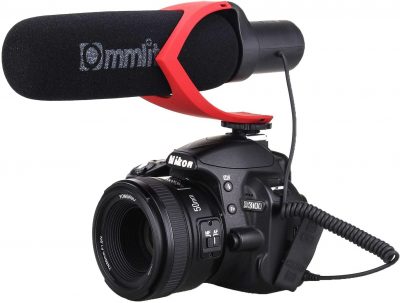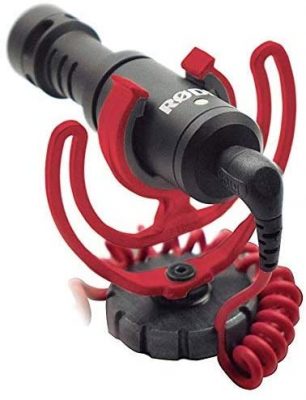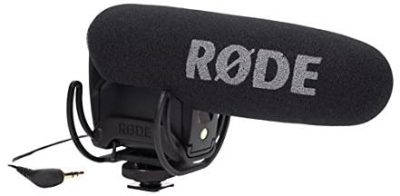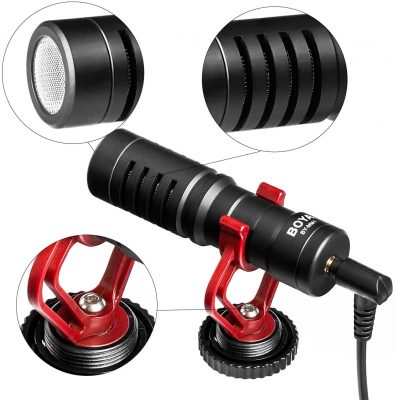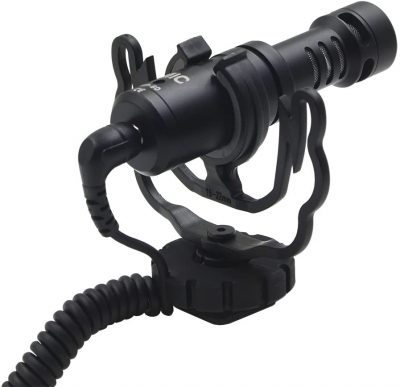Forms of entertainment have significantly expanded during the Internet age. Apart from traditional television and radio, we can now access unlimited video and audio content using our smartphones, tablets, and computers.
Video blogging, commonly known as “vlogging,” for example, is a popular way of covering certain topics. It’s a better way of explaining things and more engaging than just reading a wall of text. Vloggers with a large number of followers or subscribers also earn a massive amount of money for creating quality content.
Another popular type of content available today is podcasts. Here, creators use audio to entertain or educate their followers. According to the 2019 data of Edison Research and Triton Digital, 62 million Americans are listening to podcasts each week, which is 19 million higher than in 2013. Part of this huge growth is the increase in podcasts available for listeners today.
One secret for a successful video or audio content is clear sound. Your audience should be able to hear your voice clearly so they understand you properly. Otherwise, they may not enjoy your content and unsubscribe to your channel. If you want to improve the quality of the content you produce, consider investing in a shotgun microphone.
What Is a Shotgun Microphone?
Cameras and smartphones have built-in microphones. But oftentimes, it’s not enough to achieve the high-quality audio you would need for your content. Having an external microphone, like a shotgun microphone, will significantly improve the sound quality.
A shotgun microphone is a type of microphone that is highly directional. You need to point directly at the target sound source to record properly. The body of this microphone looks like the barrel of a shotgun, hence, the name shotgun microphone.
It uses unidirectional microphones to have a high beam concentration on the sound source when recording. Due to their design, shotgun microphones pick up sound better when the sound source is in front of them. Moving the source to the side or rear will affect the quality of the recording.
Shotgun microphones are bigger than lavaliers, a type of external microphone that you can clip onto the subject. Lavalier microphones are also compatible with different devices. Both of them work well in capturing high-quality audio.
What makes shotgun microphones an incredible tool is that they pick up the sound with high gain and they only focus on the sound source in front of them. You don’t need to worry about the other noises surrounding you because this type of microphone will record them very low. This is ideal for tasks where you have to record the sound you need and leave out unwanted noise in your environment.
Best Shotgun Microphones
Finding the right apps and equipment helps you create and produce quality content without hassle, like Adobe Premiere Rush. You can find a wide variety of shotgun microphones available in the market today. To make your search easier, here are the top shotgun microphones you should consider.
This shotgun microphone is ideal for video cameras and formal uses like interviews. You can use it with any video device that has 3.5mm TRS jack. It also has the capability to absorb the voice source clearly and accurately, whether you’re far away or up close.
Audio-Technica ATR-6550 is one of the best shotgun microphones available in the market today. It has two range settings: the Normal and Tele. The Normal setting is for close to medium-distance recording. But using the Tele setting allows you to pick up dialogue and sound effects at a distance. It will bypass ambient noise, including air-handling systems, traffic, mechanically coupled vibrations, and room reverberation.
Specifications
Transducer Principle: Condenser
Polar Patterns: Cardioid (Normal), Super-Cardioid (Tele)
Frequency Range: 70 to 18,000 Hz
Open Circuit Sensitivity: -56 dBm, 1 kHz at 1 Pa (Normal), -45 dBm, 1 kHz at 1 Pa (Tele)
Check out the Audio-Technica ATR-6550 for a high-quality audio recording.
Rode VM GO On-Camera Microphone is another high-quality microphone you should consider. First of all, it’s affordable and portable. This unit is also compatible with iOS devices and smartphones, so you can still create content using your phone without sacrificing the audio quality.
This shotgun microphone has a superior acoustic suspension and it will not let distracting noise come in the way. It focuses mainly on the sound in front of the microphone. The microphone is also integrated with Rycote Lyre shock mount, which isolates it from bumps and vibrations that could affect the overall quality of the audio.
Rode VM GO On-Camera Microphone has a straightforward design with no complex switches. It doesn’t need a battery, as well. Instead, the unit is powered by the camera’s external microphone input.
Specifications
Acoustic Principle: Line Gradient
Polar Pattern: Super-Cardioid
Frequency Range: 100 Hz to 16 kHz
Open Circuit Sensitivity: -35.0dB re 1 Volt/Pascal (17.80mV @ 94 dB SPL) +/- 2 dB @ 1kHz
Check out Rode VideoMic GO On-Camera Microphone for a high-performing and cost-efficient shotgun microphone.
Another Rode microphone in this list is the NTG2 Condenser. It is a condenser shotgun microphone that’s super light in weight, which is ideal for professional uses in industries like video, television, film, and production.
This microphone has full frequency response, audio transparency, and low noise, making it perfect for films, videos, and voice-overs. Rode NTG2 Condenser’s native 20Hz-20kHz frequency response has a selectable high-pass filter at 80Hz. It will prevent low-end noise, like traffic and air conditioners, from being recorded.
Unlike Rode VM Go On-Camera Microphone, NTG2 Condenser requires a AA battery to operate. You can also use P48 phantom power you can get from power supplies. This makes the microphone ideal for situations where your camera can have phantom power, like DSLR video.
Specifications
Transducer Principle: Condenser
Polar Pattern: Super-Cardioid
Frequency Range: 20 Hz to 20 kHz
Open Circuit Sensitivity: 36.0dB re 1 Volt/Pascal (15.00mV @ 94 dB SPL) +/- 2 dB @ 1kHz
Check out Rode NTG2 Condenser for a low-weight shotgun microphone.
This shotgun microphone is a great option if you’re looking for a shock-absorbing microphone. Comica CVM-V30 Pro Shotgun Camera Microphone has a shock-resistant design, which helps reduce the vibration noise affecting the sound quality. That makes it ideal for doing interviews, shooting videos, and recording meetings.
You can easily attach this microphone to your camera, camcorder, or a professional video device. It is compatible with any video devices with a 3.5mm TRS jack. It offers excellent performance to help you complete difficult tasks for better recording.
Comica CVM-V30 Pro operates with two AAA batteries that allow you to record up to 200 hours. It is also equipped with wind-muff and windscreen to eliminate unwanted noise in your filming environment.
Specifications
Transducer Principle: Condenser
Polar Pattern: Super-Cardioid
Frequency Range: 40 Hz to 20,000 Hz
Open Circuit Sensitivity: -33dB+/-2 dB / -23dB+/-2 dB
Check out Comica CVM-V30 Pro for a shock-proof shotgun microphone for your content production.
Comica CVM-VM10 II is an ideal shotgun microphone not only for formal videos but also for vlogging. It has a professional mic design that can absorb the accurate voice that fits your content. This is also shock-absorbing. The absorption stand is made of silica gel that helps prevent any operation shaking.
Like the Comica CVM-V30, this microphone also has a high-quality windscreen and wind muff that are helpful for outdoor recordings. But the video device powers the CVM-VM10 II, making it more convenient to use. No need to worry about replacing the battery or charging.
Another advantage of this microphone is that it is small and light. It also has an excellent anti-interference function because of its built-in metal microphone. The body is built using full aluminum that helps strengthen the anti-interference function and makes it professional to match your video device.
Specifications
Transducer Principle: Condenser
Polar Pattern: Cardioid
Frequency Range: 60 Hz to 20 kHz
Open Circuit Sensitivity: -33 +/- 2dB
Check out Comica CVM-VM10 II for a light, high-performing shotgun microphone.
Here’s another Rode microphone on our list. VideoMicro Compact is a versatile shotgun microphone, which is ideal if you’re planning to use a broad range of cameras when recording. This is one of the smallest shotgun microphones available in the market today. The unit is three inches long and weighs about 42 grams.
Since it is a compact microphone, it improves the audio quality of your videos. This model has a high-quality cardioid condenser microphone capsule that you can use for a wide range of cameras but still produces high-quality audio. It is also a directional microphone so it minimizes the distracting noise in your surroundings.
VideoMicro does not require a battery. You can power it by camera plug-in of 2V-5V DC.
Specifications
Acoustic Principle: Pressure Gradient
Polar Pattern: Cardioid
Frequency Range: 100 Hz to 20 kHz
Open Circuit Sensitivity: -33.0dB re 1 Volt/Pascal (22.00mV @ 94 dB SPL) +/- 2 dB @ 1kHz
Check out Rode VideoMicro Compact On-Camera Microphone for a versatile shotgun microphone.
VMPR Lyre Shockmount is one of the top-quality shotgun microphones you should consider for your projects. It is compatible with camcorders, DSLR cameras, and audio recorders. It offers a high-quality stereo to videographers and is perfect for recording music.
Another advantage of this shotgun microphone is that it is equipped with a shock mounting system that is Rycote Lyre-based. It disconnects the VideoMic Pro capsule and electronics from its mount. This system provides isolation from physical factors outside that can cause rumble and vibration in the microphone.
The Lyre is built with a single piece of hard-wearing thermoplastic, which provides excellent acoustic suspension to traditional elastic solutions. This construction will not wear out, snap, or sag.
Specifications
Acoustic Principle: Pressure Gradient
Polar Pattern: Cardioid
Frequency Range: 40 Hz to 20 kHz
Open Circuit Sensitivity: -38.0dB re 1 Volt/Pascal (12.60mV @ 94 dB SPL) +/- 2 dB @ 1kHz
Check out Rode VideoMic Pro Rycote Lyre Shockmount to achieve high-quality audio recording.
BOYA BY-MM1 is another lightweight shotgun microphone that is ideal for smartphones, camcorders, and DSLR cameras. It won’t add too much weight when you attach it with your device because it has a compact size and aluminum design.
This is a cardioid microphone designed to enhance the sound quality of your video. You can also operate it without a battery and directly use it with your camera. The device is equipped with an anti-shock mount, which minimizes unnecessary cable, vibration, and handling noise.
Specifications
Transducer Principle: Electret Condenser
Polar Pattern: Cardioid
Frequency Range: 35 Hz to 18 kHz +/-3dB
Open Circuit Sensitivity: -42dB +/- 1dB / 0dB=1V/PA, 1kHz
Check out BOYA BY-MM1 for a lightweight shotgun microphone.
This shotgun microphone is ideal for video projects that need interview content. Sennheiser MKE 600 is compatible with DSLR cameras and camcorders. But because of its compact design, this microphone also works with any camera. You can power using a AA battery or phantom.
It provides an exceptional directivity, which reduces the noise coming from the side of the microphone. This unit is also switchable for the low-cut filter. Sennheiser MKE 600 has an impressive suppression of the structure-borne noise to minimize the wind and handling noise.
This 10-inch microphone uses an interference tube and super-cardioid and lobar polar patterns to achieve pronounced directivity on-axis. It also has excellent attenuation of sound entering at the sides and rear. This makes it more effective at recording sounds from a distance compared to the omnidirectional microphone you usually find in most cameras.
Specifications
Transducer Principle: Condenser
Polar Pattern: Super-Cardioid , lobar
Frequency Range: 40 Hz to 20 kHz
Open Circuit Sensitivity: 21 mV/Pa (Phantom Power), 19 mV/Pa (Battery Power)
Check out Sennheiser MKE 600 if you’re looking for a compact shotgun microphone.
Gigibon is a lightweight and compact shotgun microphone that is ideal for entry-level. It is compatible with a lot of DSLR camera brands, including Nikon and Canon. You can use it when shooting promotional videos or family activities.
This microphone is easy to operate. You can simply connect it to your DSLR using a 3.5mm jack. It doesn’t require batteries as you can power it through the integrated plug-in. When it comes to recording quality, Gigibon reduces the distracting noise in the environment. It has a capacitor that helps you record crystal clear audio.
Specifications
Transducer Principle: Condenser
Polar Pattern: Cardioid
Check out the Gigibon On-Camera microphone for your DSLR camera.
What Is a Good Shotgun Microphone?
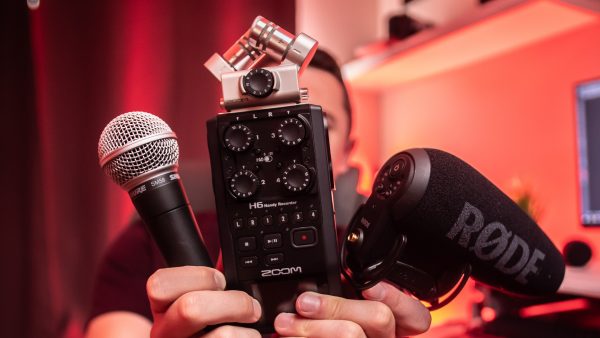
There are many apps you can download to help you improve your content. But investing in a high-quality shotgun microphone makes a huge difference. It allows you to record clear audio that perfectly goes with your videos.
The products in our list are just ten of the best shotgun microphones available in the market today. There are more high-performing microphones that are not highlighted on our list. You need to consider several factors to help you find the right microphone based on the content you make. There are microphones best for streaming but there are others designed for vlogging and podcasts.
Here are the things you should look for in a shotgun microphone to make a smart purchase.
Polar Pattern
A polar pattern is an essential factor to consider when purchasing a shotgun microphone. It affects the capability of the device to record a clear voice. For example, omnidirectional microphones capture sound from all directions. This means they will also record unnecessary noises present in your surrounding environment. Cardioid microphones, however, record sound coming from the front.
Shotgun microphones come in different polar patterns, including
- Supercardioid – it is a narrow pickup pattern and the microphone is sensitive in the front of the diaphragm. Microphones with this polar pattern reject sounds coming from off-axis.
- Hypercardioid – it has a narrower pickup pattern and longer rear pickup.
- Ultracardioid – it has the narrowest pickup pattern among the three. This type of pattern, however, is not ideal for use on a boom pole because it is highly directional. The subject can go off-axis even at the slightest movement.
Consider the kind of shoot you will be needing the shotgun microphone for. This will help you identify the right polar pattern you need from a microphone.
Frequency Response
This is also a vital factor that affects the overall performance of your shotgun microphone. Frequency response refers to how well the components of the device can reproduce the signals it picks up. Ideally, it should be a one-to-one reproduction where the microphone will hear a sound and convert it into an electronic signal that is transferred into the recorder smoothly. Vibrations, however, get lost along the way and there are data that don’t make it to the final recording.
The frequency response of microphones is usually 20 Hz to 20kHz. Knowing the range of the frequency response, however, is not enough. You should know how responsive the microphone is to certain frequencies. That is why it’s important to know what kind of content you’re recording.
Benefits of Using a Shotgun Microphone
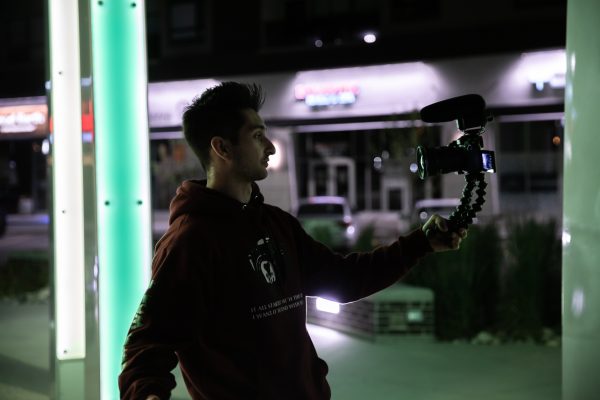
High-quality audio can be challenging to capture when shooting videos. But using a shotgun microphone makes it a lot easier due to its narrow pickup pattern. You wouldn’t need to rely on your device’s built-in microphones that usually have lower quality and broader polar pattern.
Using your device’s built-in microphone alone allows unwanted noises, like background noise and wind, to be in your recording. They are not also designed to produce high-quality audio.
Additionally, shotgun microphones have a long reach that helps in situations where you have to record at a distance. Their long and narrow pickup patterns allow them to isolate and record sound coming from a far source. Keep in mind, however, that you can’t zoom your microphone just like what you would do on a camera if you want to capture a subject from far away. Shotgun microphones can capture sound at a distance three to ten feet, depending on the model.
Connecting a Shotgun Microphone to Your Smartphone
Not all content creators own or have access to professional cameras and recorders. Many use their smartphones to shoot or record and edit their content using their smartphones. Newer mobile devices today have powerful features that can produce output with almost the same quality as professional devices.
If you plan to use a shotgun microphone with your smartphone, keep in mind that you can do that in three different ways.
Via Bluetooth
- Turn on the Bluetooth microphone (the Bluetooth technology is designed into it) or Bluetooth mic transmitter (it allows a regular wired mic to connect via Bluetooth).
- On your smartphone, open the Bluetooth menu and ensure your phone is discoverable.
- The microphone should show up as a device if the devices are within range of one another.
- Connect your microphone by clicking on it on the Bluetooth device list on your smartphone.
Via TRRS Headphone Jack
Another way to connect an external microphone to your smartphone is by using the jack. Remember, however, that the headphone jack outputs signal, and a microphone input it. Usually, smartphone headphone jacks are designed as 3.5mm Tip-Ring-Ring-Sleeve (TRRS) female phone connections.
The two wiring standards are CTIA and OMTP, and TRRS are normally wired as CTIA. Apple played a significant role in developing the CTIA standard. Because of that, many smartphones follow this standard which configures the TRRS connection as
- Tip: Left Audio
- Ring: Right Audio
- Ring: Ground
- Sleeve: Microphone
If you want to connect an external microphone to your smartphone headphone jack, you should use a 35mm TRRS male phone connector. Using 35mm TS and TRS cable will not work because the microphone signal goes through the sleeve. The sleeve of these cables is wired as ground, instead of a microphone. But you can use a headphone jack adapter to convert a 35mm TS or TRS mic connection to a 35mm TRRS connection.
Via Charger Port
There are microphones you can connect to your smartphone through the charging port of your device. If you have a USB microphone, you can connect it to your smartphone’s charging port but you need to convert the microphone’s signal to digital audio. You can do it through an ADC between the charger port connector and the mic capsule.
Start Creating Content With Shotgun Microphones
A shotgun microphone is a good investment if you’re serious about making content, be it vlogs, podcasts, or marketing materials. Keep these pointers in mind when shopping to make the most of your budget. Compare different products and see which one suits your needs. You should also consider the other equipment you use and make sure they are compatible with each other to prevent issues along the way.

